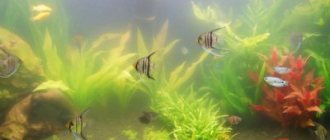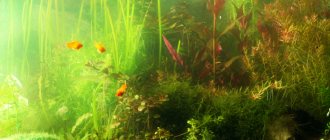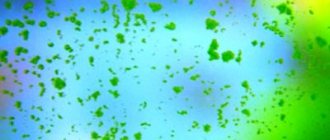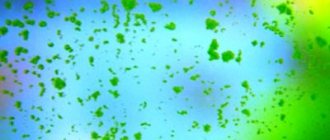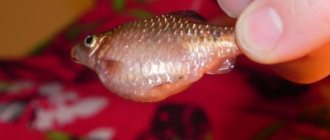Cloudy water is a common phenomenon. There are many reasons why the water in an aquarium becomes cloudy. Regardless of the source of the problem, such a pond looks unattractive, the water stinks, and the habitat becomes dangerous for all pets. Turbidity can occur for biological reasons or as a result of mechanical factors. If you take measures to restore the internal balance of water, as soon as it becomes noticeable that the water in the aquarium is becoming cloudy, then the problem can be eliminated quickly without unpleasant consequences.
Reasons for violation of cleanliness
If the water in your pet’s aquarium quickly becomes dirty, the reason may lie in:
- Rigidity
. Impurities contained in the water settle on the ground, walls of the aquarium and the heater. A white coating appears on the turtle's shell. - Stern
. Remains of uneaten or missed food settle to the bottom and begin to rot. In addition to dirt, an unpleasant odor caused by putrefactive bacteria is added. - Abundance of aquatic plants
. Usually the water turns green from overgrown xenococus or green euglena. - Insufficient hygiene
. It is common for red-eared turtles to defecate in water, so infrequent water changes contribute to the accumulation of nitrates and ammonia.
Cleaning aquarium water
How to get rid of unpleasant odor and cloudiness? The container should be cleaned. For this you will need:
- 5–10 liters of water, which has the required parameters. It is used for filling into quarantine containers.
- Container for draining water that smells unpleasant.
- Tools for cleaning the tank: scrapers, nets, etc.
- Chemicals for cleaning. They should be purchased only in specialized stores. After all, this is where consultants will help with selecting the composition and determining the cause of the smell.
- Equipment for monitoring liquid parameters.
Cleaning of the nursery begins only after all the fish and shellfish have been planted. Aerators, compressors, filtration systems and lighting fixtures are turned off. The filter and its components are washed. Replace if necessary.
A siphon is used to clean the substrate. It is also used to clean decorative elements that are concentrated in the container. After cleaning, water with the appropriate parameters is poured into the aquarium.
To avoid problems related to how to remove the smell, experienced aquarists place speckled catfish, special mollusks and other species into the tank, which clean the substrate, plants and walls of the container from organic matter and algae. After all, the main reason for the appearance of unpleasant odors is unprocessed organic matter and food residues.
Beginner aquarists are advised to regularly clean the tank. Chemical compositions that do not have a detrimental effect on the condition of fish, shellfish, or the growth of shady plants are suitable for this.
To remove remains and residues, mechanical, bottom and other filtration systems are installed. They contain elements that require periodic cleaning. For washing, use only running water.
By following fairly simple rules, you will never encounter the problem of why the water becomes cloudy, stinks, or blooms.
Tips for fighting dirt
Once you have dealt with the problem of contamination, use the following tips:
- Reduce hardness
. You can reduce the salt content by: a. bottled or filtered water; b. water softener with ion exchange resin; c. freezing of water, pushing excess dissolved salts to the center.
IMPORTANT! Take a moment before completely freezing and drain the remaining liquid from the center. This is where salt deposits are concentrated.
- Change your usual diet
. During feeding, remove the turtle from the aquarium and move it to a separate container filled with warm water. If the water quickly becomes cloudy due to uneaten food, reduce the portions. - Assess the light level
. Due to the excessive number of plants, the water not only turns green, but also emits an unpleasant odor. The problem is solved: a. decreasing light; b. using a UV sterilizer lamp; c. thoroughly washing the aquarium and equipment with soda; d. periodic water changes in large volumes. - Change the water at least 1-2 times a week and install powerful filters
. Models for indoor installation are suitable for young individuals, while adults who have gone through molting will have to add external filtration.
Article on the topic: Filter for an aquarium with a red-eared turtle: selection, installation and use
The accumulation of dirt is a favorable environment for pathogens. Keep your pet safe by keeping your own hands clean, cleaning the aquarium regularly, and having a lid that protects the water from flying dust.
Prevention
To restore biobalance and combat biological turbidity, the following measures are used:
- siphoning of the substrate;
- frequent water changes;
- increased aeration;
- adding quality water.
These measures will reduce the amount of organic material and free-swimming heterotrophs in the aquarium water. However, only filtering the aquarium water and adding a new part of the water when changing is not enough. Chemicals are used for preventive purposes.
Care products
All chemicals must be used strictly according to instructions. Before use, it is important to make sure that all components in the composition are tolerated by fish in the pond. Preparations are necessary for maximum purification of liquid for therapeutic and prophylactic purposes.
Tetra medicines ensure that small particles are converted into large flocs, so that contaminants can be retained in the filter. Used for long-term clouding. The drug tetra in the form of granules is placed inside; if the drug is in liquid form, then it is instilled in the required dose. The positive effect is noticeable after 3 hours; after 12 hours of cleaning, the water will become perfectly clean. The product is safe and is used before a photo shoot in an artificial pond.
Sera aquaria clear is an analogue of tetra. Bound dregs are removed with this product in a few minutes. The drug sera has a biological effect; the drug does not contain active harmful components.
To get rid of nitrates and nitrites in a short time, the drug sera bio nitrivec is used. The product is designed to launch an artificial reservoir in a short period of time. Bio nitrivec contains a mixture of various cleansing beneficial bacteria. After using it, the fish can be released inside a day later, the effect lasts for a long time.
The water of red-eared turtles turns yellow
Tell me how to solve the problem.
There are 15 liters of water in the aquarium, there is a large external Astro filter of 7 liters of water in it, filled with bioceramics, then an absorbent - something like activated carbon (I don’t remember what it’s called), then a sponge. At the filter inlet there is a sponge, clean after 1-2 days. Aeration.
There live two turtles, Herringbone - 200 grams and Cross - 300 grams.
There are no plants, no soil, no snags - just glass.
After starting the filter, the water does not smell, does not become cloudy, but after a month it turned yellow.
After changing the water it began to turn yellow faster, after two weeks it was almost brown.
How to figure out what the reason is, maybe buy some tests? I read somewhere that this is deutrite - dead bacteria, can remove bioceramics, leaving only mechanical cleaning? Or is the filter not coping with the waste? Is there chemistry for this?
The filter has only been in use for 2 months and has not been cleaned.
PS Grandma gave the child two turtles, now dad is an avid aquarist.
Jenshen said: 04/05/2011 14:43
We feed him gamarus - the large turtle completely refused to eat fish and squid, although he had eaten before. The little one prefers pollock and squid.
I've read that exteriors haven't been cleaned for years. You can change the absorbent, it would make sense.
Do you think increasing the volume of the aquarium will solve the problem?
What about tests? Are they any use?
They gave me an aquarium 100 cm by 60 cm and 73 cm high, now I don’t know what to do with it, it doesn’t fit anywhere. I would replace it with a smaller one, 40 centimeters wide.
Article on the topic: Caring for a turtle aquarium: cleaning and maintenance
Jenshen said: 04/05/2011 15:16
We feed them as if for slaughter, twice a day, there is no food left - but they grow right before our eyes. We internally call them cutlets.
We need to put them on a hunger strike if their nerves can stand it - when they see a person being rowed like motor boats. I read somewhere - feed it generously once every three days, you should try it.
How to remove chlorine from water for an aquarium
Before returning your pets to their place, you must first prepare the water so that it is suitable for them. Tap water cannot be used in this case, as it contains chlorine residues. The water must first settle and be filtered from impurities. You can buy a special solution in the store that destroys all remaining chlorine. After installing the heater, you need to wait until the water reaches a temperature of 22-26 0C.
You can use live bacteria to clean your aquarium to make the water suitable for plants and reduce daily contamination. Bacteria act as a biofilter, destroying food and waste that cannot be removed manually, so with their help the water stays clean longer. You can protect your pet from infections by adding salt in the proportion of 1 tbsp. for 4 liters of water.
After completing all preparatory operations, the pet can be returned to its place in the terrarium. To reduce stress after relocation and change of conditions, you should give the turtle some kind of treat.
REFERENCE! It happens that after a change in the composition of the water, a turtle may begin to molt. There is no need to be afraid of this, since this process is harmless and natural.
To check the suitability of water, it is best to use an acidity test (pH), which can also be purchased at pet stores. Information about the composition of the water can be obtained by changing the color of the test paper.
Green plaque on the walls: how to get rid of it?
Brown plaque is caused by the development of brown algae. The reason for its formation is the lack of light in the aquarium. As in any living body of water, in our closed underwater world there are all types of microorganisms, bacteria and algae.
An imbalance leads to rapid development of a particular organism. Brown plaque is eliminated by leveling the lighting to normal. Wash the walls, change a little water and add light - and you're done.
Brown algae problem solved. Most often this happens due to their replacement with green algae, as they are more highly organized.
The most famous from the school biology course is Euglena green. It is this algae that is the main cause of green water. The coating is formed by green algae of other species - filamentous edogonium and xenococus.
These are the most common green algae that grow on the walls of the aquarium and stones on the ground. Dealing with them is much more difficult, so we will consider all the ways.
- The main reason for the rapid development of green algae is excessive lighting . Avoid direct sunlight on the aquarium. The distance to the window must be at least 1.5 meters. Select artificial lighting lamps at a rate of 0.5 W/l for no more than 8 hours a day. With a higher pH in the aquarium, green algae also grow less rapidly.
- Regular cleaning of walls and partial water changes . Take care of your underwater world and you will avoid many problems. Cleaning the walls should be done with a soft sponge; cutting with a blade is a last resort. Scratches on the glass allow algae particles to remain and continue to multiply. Water changes should not be more than ¼ of the total volume.
- Biological cleaning method . This is the most desirable method. Many species of aquarium fish feed on algae. Almost all viviparous animals include guppies, swordtails, platies and mollies. Crucians, goldfish, veiltails, and telescopes also diversify their diet with greens. Experts say that the better aquarium plants grow, the less algae multiply. A variety of snails will be of great help in cleaning the walls and water. They eat the remains of the remaining food, some filter the water through themselves, thus feeding on unicellular algae. Ampularia love to chew algae off glass. But, as with everything, you need to observe moderation. Daphnia and cyclops can quickly clear the entire volume, but they themselves are tasty prey for fish.
- Salting the water. In this article we are looking at freshwater aquariums. Sea walls are not overgrown with green algae; they have their own problems. If acidifying the water is impossible due to the presence of certain types of fish, you can try adding salt to the water, no more than 1 g/l. Salt will retard the development of green algae in the water.
- Chemical method . Antibiotics are useful in the fight against bacteria and lower algae if the problem has gone too far and other methods do not help. You can treat the aquarium with Riboflavin, Tripaflavin, Rivanol (0.1 g per 100 l). But when these substances are used, snails and some aquarium plants with delicate green leaves suffer. Cabomba and hornwort will drop their leaves immediately after applying these medications. Streptomycin and Penicillin are less harsh. Plants and fish will not be harmed. The dose of Streptomycin used is 0.3 mg/l for 48 hours, then the water should be changed. The safest chemical for disinfecting an aquarium is 3% hydrogen peroxide. Concentration from 2 to 6 mg/l with enhanced aeration. No water change required.
Why is this problem dangerous?
Green water itself is not dangerous for fish, but its causes can cause irreparable harm.
In addition, due to a lack of lighting, the photosynthesis process in plants slows down, they do not release oxygen, which is so important for the respiration of fish, shrimp and even beneficial bacteria.
Therefore, it is so important to use enhanced aeration during this period.
Also dangerous are dead parts of plants that begin to rot, thereby filling the aquarium water with organic compounds and further aggravating the situation. It is not advisable to feed the fish during this period; they, of course, will not die of hunger, but it will cause them some discomfort.

